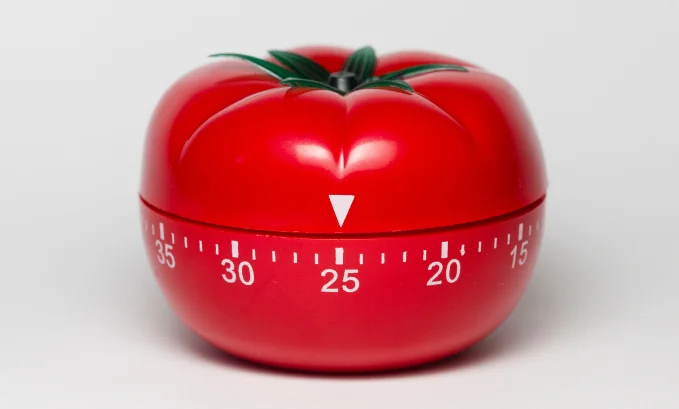On Saturdays, we serve food for thought, which might challenge what you believe are the “right” ways to spend your time! Today’s subject is the Pomodoro Technique! Today’s post is short and sweet—some would say the perfect 5-minute read – I promise you’ll understand.
Do you ever find yourself procrastinating or losing focus as the day goes on? Well, you’re not alone—many hardworking people simply “burn out” after performing tasks for an extended time. But what if I told you there exists a simple, yet effective method to combat these dips in productiveness? Invented in the early 1990s by college student Francesco Cirillo, the Pomodoro Technique is an interval-based study method aimed to increase productivity and limit distraction. Funnily enough, the name of this method came from the tomato-shaped timer that Cirillo used to track his study intervals. But don’t let the silly name fool you; the Pomodoro Technique is incredibly effective in its ability to offset peoples’ limited attention spans.
The theory behind this technique is simple; any large task or series of tasks can be broken down into segments called “Pomodoro’s”. Each of these intervals is then separated by a short break. Most commonly, it sees 25 minutes of intense focus followed by a 5-minute break.
Optimally, one would perform 4, 30-minute Pomodoro cycles (2 hours) before extending their rest period, to which you can decide. The success of this technique lies in what you do with your breaks. First and foremost, you should remove yourself from the study environment. This ensures that your mind can differentiate between a place of work, and a place of leisure. Secondly, avoid distractions that risk the extension of your designated break time … yes, I’m talking about your phone!
Cirillo himself recommends the “inform, negotiate & call back” strategy. This involves informing third parties (potential distractions) that you are in the middle of something, negotiating a time at which you can get back to them, and calling back when you are finished. Similar to resting in-between sets (of a workout), this helps maintain intensity in your performance; keeping the rest at a minimum allows for effective mental recovery, but not a loss of focus.
This technique is not exclusive to studying, and can be implemented in any task-oriented situation. For individuals who work from home, this can be particularly effective … trust me, I know how annoying it can be to stare at a screen for hours on end. Following a structured time schedule and taking small breaks in-between tasks will allow you to maintain focus-levels.
Ultimately, you can get more done by doing less! If you are looking to implement this method in your routine, here are a few things to keep in mind:
• Get started by keeping the commitment small! Obviously, we all have tasks that we must complete. Yet, designating 8-10 hours to work (and work alone) can be a tad gratuitous. Start with a smaller block of 1-3 hours instead. This will allow you to build momentum as you go without any underlying feelings of being overwhelmed!
• Do not feel obligated to take breaks if you’re in the “groove”! For longer tasks, which require a larger time commitment, taking breaks will sustain your mental stamina and prevent burnout. But if you are doing something that can be achieved by going nose to the grindstone (no breaks), do so at your discretion.
• The Pomodoro Technique is but a TEMPLATE, so make it work for you! The above-mentioned, 30-minute cycle is the “traditional” application of this technique, but can be varied by individual need. If you prefer to work for 50 minutes and take a 10-minute break, that is perfectly fine! Pick an interval that you know you can complete and repeat without distraction or burnout.
So, how did I do? Were you able to read this in under 5 minutes? Oh, look at the time … your break is over! I appreciate your breaking rule number 2 (no phone during breaks) to read my post, but you have more important things to do! Start the timer and get back to work! Until next time…
Author: Ryan Alvarez
References
Med School Insiders. (2016). Pomodoro Technique – My Favorite Tool to Improve Studying and Productivity. YouTube. Retrieved December 15, 2022, from https://youtu.be/mNBmG24djoY.






